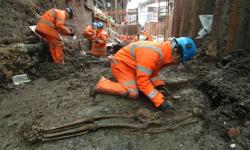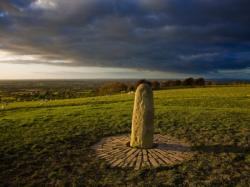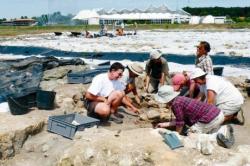INSTITUT SUPERIEUR D'ANTHROPOLOGIE
INSTITUTE OF ANTHROPOLOGY
ONLINE COURSES / COURS A DISTANCE
INSCRIPTION 2012 / Session III : Juillet 2012
REGISTRATION 2012 / Term III : July 2012
ROYAUME UNI –  Londres - One poor Victorian Londoner has been buried in a style – after a cathedral service at Southwark, in a crimson-leather-covered coffin with a specially engraved brass plate – that he could never have dreamed of, in an unusual ceremony to give a permanent resting place to the bones of hundreds of individuals disturbed by the construction of a railway viaduct. The remains have been reburied at a brand new cemetery at Kenmal Park in Chislehurst, on the south-eastern outskirts of London. Their common grave will be marked for the first time with a memorial: originally they were buried in the cheapest coffins in unmarked graves. One skeleton was selected as "the unknown parishioner", and had a solemn funeral service at Southwark Cathedral, followed by burial with the others. Archaeological analysis revealed that the 331 individuals lived short, hard lives. Almost a third died before reaching the age of 18, only a handful made it to over 45, and none was older than 60. Evidence was found of scurvy and rickets, classic diseases of poverty in 19th-century England, some had deformed ribs presumed to be from tight-laced corsets, and others had permanently damaged teeth from perpetual pipe-smoking. Analysis of the finds continues by Oxford Archaeology, but Chris Place, Network Rail's archaeologist, said they had already fully recorded the bones. "We will eventually know everything there is to be known about these people – except their names," he said. It is unlikely that any individual will ever be identified. There are no surviving records for many of the small burial grounds in the district and no grave markers of any kind were found. They were, however, lucky to have remained in their graves: the area was infamous for "resurrection men", grave robbers who dug up freshly buried corpses to sell to schools of anatomy. Although the coffined burials found by excavators from the Museum of London Archaeology were undisturbed, they found evidence of many more that had been broken up once or even twice before. The viaduct was driven by Network Rail through Borough as part of the Thameslink improvement project, clipping the edge of the famous market. It runs through the heart of what was once the most densely populated district of London's south bank, and the site of the old St Saviour's almshouse burial ground, which opened in 1730 but was partly destroyed by earlier railway works. The archaeologists found pits holding jumbled bones reburied by the Victorian railway navvies who built the railway lines in the 1860s.
Londres - One poor Victorian Londoner has been buried in a style – after a cathedral service at Southwark, in a crimson-leather-covered coffin with a specially engraved brass plate – that he could never have dreamed of, in an unusual ceremony to give a permanent resting place to the bones of hundreds of individuals disturbed by the construction of a railway viaduct. The remains have been reburied at a brand new cemetery at Kenmal Park in Chislehurst, on the south-eastern outskirts of London. Their common grave will be marked for the first time with a memorial: originally they were buried in the cheapest coffins in unmarked graves. One skeleton was selected as "the unknown parishioner", and had a solemn funeral service at Southwark Cathedral, followed by burial with the others. Archaeological analysis revealed that the 331 individuals lived short, hard lives. Almost a third died before reaching the age of 18, only a handful made it to over 45, and none was older than 60. Evidence was found of scurvy and rickets, classic diseases of poverty in 19th-century England, some had deformed ribs presumed to be from tight-laced corsets, and others had permanently damaged teeth from perpetual pipe-smoking. Analysis of the finds continues by Oxford Archaeology, but Chris Place, Network Rail's archaeologist, said they had already fully recorded the bones. "We will eventually know everything there is to be known about these people – except their names," he said. It is unlikely that any individual will ever be identified. There are no surviving records for many of the small burial grounds in the district and no grave markers of any kind were found. They were, however, lucky to have remained in their graves: the area was infamous for "resurrection men", grave robbers who dug up freshly buried corpses to sell to schools of anatomy. Although the coffined burials found by excavators from the Museum of London Archaeology were undisturbed, they found evidence of many more that had been broken up once or even twice before. The viaduct was driven by Network Rail through Borough as part of the Thameslink improvement project, clipping the edge of the famous market. It runs through the heart of what was once the most densely populated district of London's south bank, and the site of the old St Saviour's almshouse burial ground, which opened in 1730 but was partly destroyed by earlier railway works. The archaeologists found pits holding jumbled bones reburied by the Victorian railway navvies who built the railway lines in the 1860s.
http://www.guardian.co.uk/uk/2012/jun/14/unknown-victorian-londoner-reburied?newsfeed=true
VIET NAM - Rach Nui - The discovery of a 3500-year-old Vietnamese toilet could yield important clues about early South-East Asian society, scientists say. Archaeologists have found what is believed to be Vietnam's earliest latrine during the excavation of a neolithic village in the country's south. More than 30 preserved faeces from humans and dogs containing fish and shattered animal bones have been located in the five-metre tall ancient mound called Rach Nui. "A detailed analysis of these will provide a wealth of information on both the diet of humans and dogs at Rach Nui but also on the types of parasites each had to contend with," Australian National University team leader Dr Marc Oxenham said in a statement. The group hopes the find will give up clues about how the region changed from a traditional hunter gatherer society to an agricultural community. "What we tend to find in places like southern Vietnam is a lot more evidence of these people in the landscape," Dr Oxenham said. "Because they were sedentary and the population size was expanding they left mounds like Rach Nui with evidence of their lives. "Their trash built up over time in one place." Among the remnants were betel nut and foxtail millet, which Dr Oxenham said is really exciting. "It not only confirms that this community was growing domesticated crops at this time but this variety of millet is from China and may provide clues into the origins of farming in southern Vietnam and indeed South-East Asia as a whole."
http://www.sbs.com.au/news/article/1659203/Toilet-discovery-gives-scientists-hope
INDE – Dehli - Has a long-lost Shahjahan-era Mughal mosque been found by Delhi Metro diggers? That's what chief minister Sheila Dikshit wants the Archaeological Survey of India to confirm. And her apprehensions are justified as locals have claimed that diggers have unearthed remains of the 17th century Akbarabadi Masjid — a claim that DMRC has denied. A senior government officer said ASI experts have been asked to be present at the digging site to ensure that if there are any mosque ruins, those are protected. "No one can deny a mosque stood there and was demolished later," said the officer. The mosque was constructed by Shah Jahan's wife Akbarabadi Begum and was situated in the Netaji Subhash Park area near Jama Masjid. But the British demolished it after the Revolt of 1857.
http://timesofindia.indiatimes.com/city/delhi/Metro-diggers-find-Mughal-mosque/articleshow/14107508.cms
IRLANDE –  Tara - Gardai are hunting vandals who attacked a 5,500-year-old standing stone at the Hill of Tara in Co Meath with a hammer. Damage has been caused in 11 places on all four faces of the Lia Fail Standing Stone -- also know as the 'Stone of Destiny' -- which is mentioned in ancient texts about the High Kings of Ireland.
Tara - Gardai are hunting vandals who attacked a 5,500-year-old standing stone at the Hill of Tara in Co Meath with a hammer. Damage has been caused in 11 places on all four faces of the Lia Fail Standing Stone -- also know as the 'Stone of Destiny' -- which is mentioned in ancient texts about the High Kings of Ireland.
http://www.independent.ie/national-news/hammer-vandals-damage-5500yearold-stone-of-destiny-3138292.html
FRANCE –  Jonzac - Le maire, Claude Belot, le confie volontiers : « En dix ans, ici, nous avons conduit des démarches qui nous ont enrichis intellectuellement et matériellement sur notre passé. À Jonzac, l'archéologie préventive est une culture. » Il en veut pour preuve le site paléolithique de Chez Pinaud, qui retrace une occupation humaine remontant entre 70 000 et 35 000 ans, et on est là dans la Préhistoire ; mais aussi les dernières fouilles conduites sous le parvis de l'église, en 2009, qui ont enfin révélé la trace d'une époque médiévale qui manquait à la ville, comprise à peu près entre les VIe et le XIIe siècles. Et ce, alors que la villa gallo-romaine, qui fait l'objet de fouilles depuis dix ans, nous livre chaque été quelques éléments supplémentaires nous permettant de prendre conscience de l'occupation romaine entre les Ier et le VIIe siècles. Ces dix ans de fouilles, justement, valaient bien une exposition. Elle ouvre demain, samedi, au moulin de chez Bret, et présentera plus de 250 éléments trouvés dans et aux abords de la villa. C'est la toute première fois qu'ils seront présentés au public. « Cette exposition présente des objets de la vie quotidienne, quelques bijoux, des éléments de parures, des pièces de monnaie, des céramiques, des pots à cuire, de la vaisselle ordinaire ou plus sophistiquée. Mais également des éléments de décors comme des morceaux de marbre, de colonnes, des enduits peints. Cette exposition montrera aussi des outils agricoles, plutôt métalliques, dont on se servait pour le travail des champs, de la vigne ou pour l'élevage », détaille Valérie Mortreuil, archéologue.
Jonzac - Le maire, Claude Belot, le confie volontiers : « En dix ans, ici, nous avons conduit des démarches qui nous ont enrichis intellectuellement et matériellement sur notre passé. À Jonzac, l'archéologie préventive est une culture. » Il en veut pour preuve le site paléolithique de Chez Pinaud, qui retrace une occupation humaine remontant entre 70 000 et 35 000 ans, et on est là dans la Préhistoire ; mais aussi les dernières fouilles conduites sous le parvis de l'église, en 2009, qui ont enfin révélé la trace d'une époque médiévale qui manquait à la ville, comprise à peu près entre les VIe et le XIIe siècles. Et ce, alors que la villa gallo-romaine, qui fait l'objet de fouilles depuis dix ans, nous livre chaque été quelques éléments supplémentaires nous permettant de prendre conscience de l'occupation romaine entre les Ier et le VIIe siècles. Ces dix ans de fouilles, justement, valaient bien une exposition. Elle ouvre demain, samedi, au moulin de chez Bret, et présentera plus de 250 éléments trouvés dans et aux abords de la villa. C'est la toute première fois qu'ils seront présentés au public. « Cette exposition présente des objets de la vie quotidienne, quelques bijoux, des éléments de parures, des pièces de monnaie, des céramiques, des pots à cuire, de la vaisselle ordinaire ou plus sophistiquée. Mais également des éléments de décors comme des morceaux de marbre, de colonnes, des enduits peints. Cette exposition montrera aussi des outils agricoles, plutôt métalliques, dont on se servait pour le travail des champs, de la vigne ou pour l'élevage », détaille Valérie Mortreuil, archéologue.
http://www.sudouest.fr/2012/06/15/dix-ans-de-fouilles-valent-bien-une-exposition-743953-4720.php